|
BILIARY MUCOCOELE

BILIARY MUCOCOELE: A SURGICAL LIVER DISEASE OF DOGS
|
It all starts with a sick, usually middle-aged or older dog. He is listless, not eating, maybe having vomiting and/or diarrhea, fever. These are symptoms that could mean any number of things but usually when he reaches the veterinarian’s examination table he has jaundice (yellow pigmentation visible in the whites of his eyes and possibly on his skin and gums). Hospitalization is recommended to rehydrate him and provide supportive care and blood tests point to a liver problem. Medications are administered to minimize the liver’s workload but soon ultrasound is being discussed to image the liver and costs may be rising quickly.
The alphabet soup of blood tests can be confusing and it can be tempting to wait a few days and see how medical support works out before imaging. While this may be a fair choice depending on the patient, there is an important reason to image the liver quickly and this reason is the possibility that surgery is needed urgently.
|
|
In a survey of dogs with
hepatobiliary mucocoeles,
the following symptoms were observed:
Vomiting – 77%
Lethargy – 73%
Appetite loss – 71%
Jaundice – 47%
Abdominal pain – 44%
Diarrhea – 29%
Fever – 22%
|
If the patient has a surgical disease,
he/she will not get better until surgery is performed.
Further, it is possible that a surgical emergency is afoot
(not only will surgery be needed but it will be needed immediately).
The sooner the surgical patient is identified, the better the chance of survival.
WHY DO WE NEED ULTRASOUND IF WE ALREADY KNOW THE PROBLEM IS LIVER DISEASE?
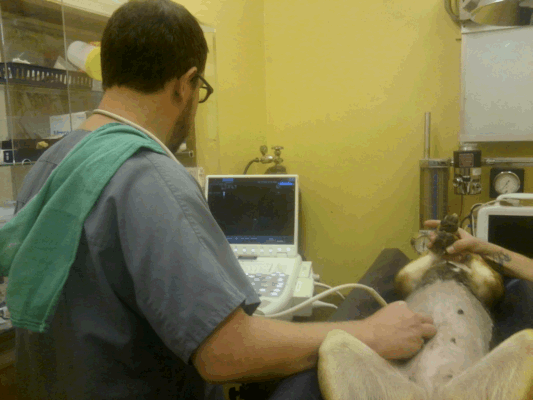
Dr. Jon Perlis of DVMSound at our hospital performing ultrasound exam.
(original graphic by marvistavet.com)
While blood testing can point to the liver, the fact is that there are numerous diseases that can affect the liver. The liver can have an infection or cancer or scarring (cirrhosis) or any number of conditions and the more specific our diagnosis gets, the more specific treatment can be.
Ultrasound represents a non-invasive way to evaluate the internal texture of the liver and gall bladder. By looking at the liver’s texture it is possible to see a tumor and determine if removing it is possible or if it has invaded too far. Ultrasound can evaluate scarring and abscessation. Through ultrasound it is possible to guide a biopsy needle to an exact area to sample tissue should this be deemed necessary.
Ultrasound evaluates the gall bladder and bile ducts. One of the more important diseases to rule out promptly is the biliary mucocoele because it commonly represents a surgical emergency. As we will describe in more detail, a biliary mucocoele is basically a wad of sludged mucus inside the gall bladder. If one waits a few days to see how the patient responds to general liver support, it may be too late. Further, ultrasound allows for evaluation of the integrity of the gall bladder for if the mucocoele ruptures and spills bile into the belly, not only will the surgeon need to know that but additional treatment for this complication is needed. Ultrasound also evaluates concurrent abdominal conditions that might bear on recovery, including pancreatitis which can present with very similar symptoms or might be present along with a biliary mucocoele.
WHAT IS THE GALL BLADDER AND WHAT IS THE BILIARY SYSTEM?
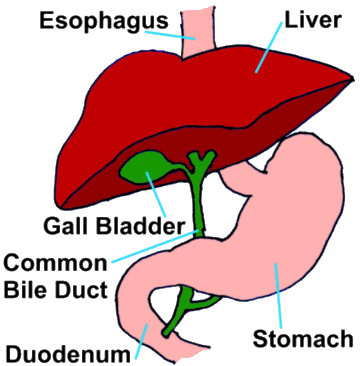
(original graphic by marvistavet.com) |
The liver serves as a toxic waste processing center for the body. It filters bacterial products (as well as nutrients) entering the body from the gastrointestinal tract and it removes toxic waste products from the bloodstream. This material is bound to special biochemicals called bile acids and the body would like to get rid of it, bile acids and all. The solution of bile acids, water, mucus, pigments, and cholesterol forms the greenish yellow fluid we call bile.
Bile is made in the liver, collected into small ducts called bile ductules and bile ducts and moved into the greenish round organ called the gall bladder for storage. During food digestion, hormones cause the gall bladder to contract and squirt bile through the large common bile duct and into the intestine. The bile assists with digestion and carries toxins out of the body so they may be eliminated in feces. The gall bladder and its ducts represent the biliary system.
IF THE BILIARY TRACT BECOMES OBSTRUCTED,
THE PATIENT BECOMES RAPIDLY JAUNDICED, PAINFUL, AND SICK.
|
WHAT IS A BILIARY MUCOCOELE?
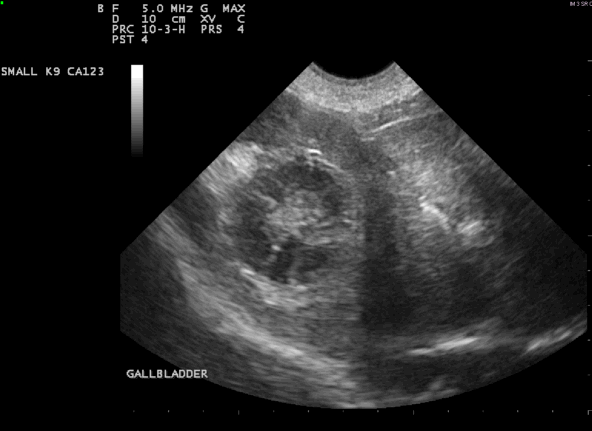
The gall bladder with a mucocoele develops an appearance on ultrasound described as resembling the cut surface of a kiwi fruit. In fact, the biliary mucocoele is sometimes called a "kiwi gallbladder."
(Photo Credit: DVMSound) |
We mentioned that one of the components of bile is mucus. In fact, normal bile is probably less than 3% mucus but when a mucocoele develops, the bile becomes mostly mucus. Normal bile is very liquid but mucocele bile is thick and goopy and will not flow easily through the common bile duct. The gall bladder distends and if it actually ruptures, it is likely the patient will likely die.
The gall bladder with a mucocoele develops an appearance on ultrasound described as resembling the cut surface of a kiwi fruit. When this is seen on ultrasound in a jaundiced sick patient, surgery to remove the diseased gall bladder should be performed as soon as possible.
|
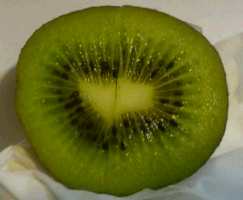
(original graphic by marvistavet.com) |
|
WHY DOES THIS HAPPEN?
|
Mucocoele development starts with delayed gall bladder contraction with allows bile acids to accumulate. Altered fat metabolism is also associated with reduced gall bladder contraction resultant bile acid accumulation. With bile acid accumulation, the lining of the gall bladder feels inflamed and responds by making more mucus and more mucus producing glands. Pretty soon the bile is just a big wad of congealed mucus and it will not flow.
Several hormone imbalances have been associated with altered fat metabolism and reduced gall bladder contraction: diabetes mellitus, hypothyroidism, and Cushing's disease. In fact, Cushing's disease patients have an incidence of biliary mucocoele development that is 29 times the incidence of patients without Cushing's disease. Mucocoele development has been linked to pancreatitis (inflammation of the pancreas) as well.
|
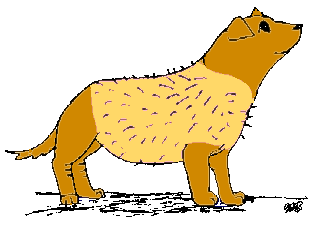 Dogs with Cushing's disease have an Dogs with Cushing's disease have an
adrenal hormone/cortisol excess that gives
them a poor hair coat (sparing the head and legs),
pot belly, excessive thirst and debilitated state.
For more information, click here.
(original graphic by marvistavet.com) |
Having Cushing’s Syndrome increases a dog’s risk of developing a biliary mucocoele by 29 times
Oddly, the biliary mucocoele, which is now a fairly common cause of canine liver disease, was only rarely seen before the 1990’s. No one knows why this might be so but it does correspond to the mainstreaming of diagnostic ultrasound into general practice.
The Shetland sheepdog, cocker spaniel, miniature schnauzer and dachshund seem predisposed to developing biliary mucocoeles.
|

Shetland Sheepdog
(Photocredit: MorgueFile.com)
|
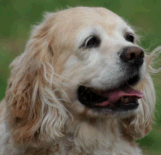
Cocker Spaniel
(Photocredit: MorgueFile.com)
|

Miniature Schnauzer
(Photocredit: PublicDomainPictures.net)
|

Pomeranian
(Photocredit: MorgueFile.com)
|
REMOVING THE GALL BLADDER (CHOLECYSTECTOMY)
|
Removing a dog’s gall bladder is a serious surgery generally requiring referral to a surgical specialty practice. The goal of therapy is to remove the gall bladder before it ruptures. If it has already ruptured, tissue damaged by the rupture must be cleansed and/or removed. If the mucocoele has become infected, ruptured, and has spilled infected bile into the abdomen this is a particularly disastrous outcome but statistically survival rate is not impacted by this.
Mortality rate with mucocoele surgery has been reported as high as 20-25%.
The gall bladder’s function is mainly one of bile storage. Without the gall bladder, bile simply dribbles into the intestine constantly rather than in controlled squirts. One might think this would be a problem but it turns out not to be. Some patients require long term medication for liver support but generally speaking, if the dog recovers from surgery prognosis is excellent and the patient can return to normal life.
|
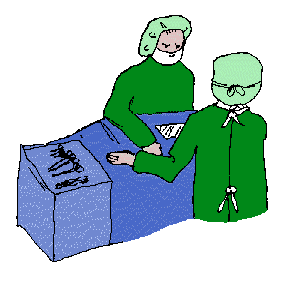 (original graphic by marvistavet.com) (original graphic by marvistavet.com) |
WHAT IF SURGERY IS NOT AN OPTION OR WHAT IF THE DOG ISN'T THAT SICK?
There is no question that surgery is the best treatment choice but there is more to the story. Biliary mucocoeles can be in an incidental finding in dogs that are not sick or who are sick from something else and are having ultrasound of the belly for some other reason. In the patient that is not experiencing problems with a mucocoele, medication may be able to stave off illness.
As for skipping surgery in a dog that is sick from its mucocoele, this is a risky move but survival is possible.
It is possible to attempt treatment with general liver support medications, low fat diet, and choleretics (medications to help liquefy bile, such as ursodiol) but the problem is that the gall bladder is obstructed with a big wad of goop. This goop is unlikely to liquefy in a timely fashion if at all, no matter what we do. If medical management is attempted, it is important to regularly recheck the gall bladder by ultrasound to watch for any sign of progression that would indicate that surgery should no longer be postponed.

Page posted: 8/12/2012
Page last updated: 1/13/2023
|